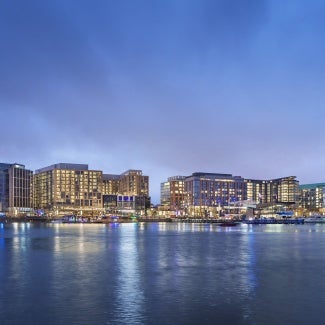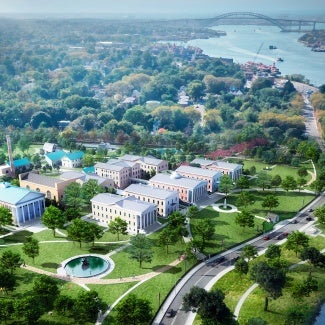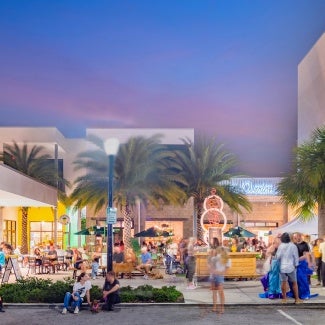Railyard Park
The award-winning regional and urban design for Railyard Park in Rogers, AR honors the city’s railroad-focused legacy while spurring economic development and authentic placemaking.

Project highlights: East End Transformation
- Architect: Ross Barney Architects, AFHJ Architecture/Planning
- Owner: City of Rogers, Arkansas
- Location: Rogers, Arkansas
The railroad that cuts through downtown Rogers, Arkansas serves as the center of its initial 1880s plan and the very reason for the city’s founding. For years, Rogers served as a water stop for locomotives running along the Frisco Line between St. Louis and San Francisco. Railyard Park, which sits at the city’s geographic high point, honors the city’s railroad-focused legacy while spurring economic development and authentic placemaking. An active railroad still runs adjacent to the site, so it remains interwoven into the city’s fabric, architecture, and future growth.
Unlike other towns born in the 19th-century railroad era, Rogers lacked a town square. Prior to Railyard Park’s completion, the five-acre site included an array of parking lots, ad hoc spaces, and a prefabricated auto repair shop that hosted a farmers market. The project, steered through a robust community engagement process, has consolidated and linked new programs in a successful effort to recenter Rogers’ downtown area.
The project kicked off with many workshops and open houses that relied on a series of participatory and visual tools. In addition to in-person programs, the team conducted public outreach through an online survey that garnered more than 1,000 responses, forming the basis of an analysis of key priorities for the park. The significant volume of data generated shaped the vision for the park and generated a sense that community members were a true, and critical, part of the design process.
When it arrived, the original railroad brought with it rapid growth, but it divided the downtown area’s east and west sides. The space abutting the railroad became a freight yard, leaving no centrally located town green or gathering space. The overarching intention of the project was to stitch east and west together through activated pedestrian spaces.
Parallel to the railroad tracks, the new Frisco Plaza includes an allée of trees and natural canopies that offer shade and seating options near a wood-decked event space. Inspired by the railroad’s original water stop, a splash park features three water towers adorned with the work of international artists. Nearby, the Playard includes play elements in bold colors for children of all ages while the Pump Building and Restroom Building reflect Rogers’ industrial heritage through their shipping container construction.
Railyard Park has bolstered visitation to Roger’s downtown since opening in 2021, boosting revenues for the surrounding businesses in turn. The park’s central event stage was an instant hit, and an inaugural concert season attracted more than 15,000 people, 60 percent of whom were local. A subsequent fully booked season followed in 2022. Frisco Plaza, which is mile zero for a 37-mile multiuse trail that connects to other major northwest Arkansas cities, now serves as host for the weekly farmer’s market and the city’s very popular holiday parade and tree celebration.
The region’s population has more than doubled in the past 25 years and is expected to do so again by 2040, prompting an inevitable series of equitable planning and design challenges. Railyard Park is a critical component of a much larger vision for northwest Arkansas, one of pedestrian-centric activity and significantly enhanced connectivity. To that end, a multimodal regional bus and rail station were developed just south of the park, and the city worked to consolidate parking around the downtown perimeter to better support the pedestrian center.
Project team & jury
Civil Engineering and Land Surveying: CEI Engineering Associates, Bentonville, AR
Structural Engineering: Goodfriend Magruder Structure, Chicago, IL
MEP Engineering: HP Engineering, Rogers, AR
Lighting Design: Schuler Shook, Chicago, IL
Branding and Environmental Graphics: SPAN (formerly Thirst) Chicago, IL
Associate Architect: AFJH Architects, Fayetteville, AR
AV Consultant: Crowne Group, Fayetteville, AR
Contractor/Construction Manager: Nabholz Construction, Rogers, AR
Photography: Kate Joyce Studios, Stephen Ironside Photography and Walton Family Foundation (c) Kerri McMahon
Victor Buchholz, AIA, Chair, LPK, Memphis, Tenn.
Kotaro Nakamura, AIA, RNT Architects, San Diego
Marilys Nepomechie, FAIA, Florida International University, Miami
Vanessa Quirk, New York
Yuting Zhang, AIA, Gensler, Boston
A Regional & Urban Design Award recognizes the best in urban design, regional and city planning, and community development.
Five projects showcase 2023's best planning projects that account for the entire built environment, local culture, and available resources.













